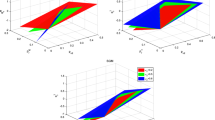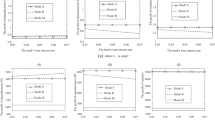Abstract
Based on the previous researches on closed-loop supply chain (CLSC), this paper takes the life cycle attributes of products into consideration and investigates the situation in which the manufacturer has a tendency to invest in green innovation and establish alliance with other supply chain members. In a two-cycle CLSC consisting of one manufacturer, one retailer and one-third party recycler, Stackelberg game method is adopted to analyze and compare the optimal decisions and profits of CLSC members as well as the efficiency of three green innovation alliance modes. The results show that the impact of difference among those three alliance modes on CLSC decision is obvious, and the operational efficiency of CLSC is always higher than that without alliance. From the perspective of consumers, environmental protection and profits, the green innovation alliance formed by manufacturer and retailer enjoys the lowest price, the highest green innovation level, the highest alliance profit and the relatively high level of resource recycling, which is the best choice for manufacturer. Finally, numerical examples are presented to obtain some conclusions and give some management inspirations intuitively. It is found that the coefficient of profit reduction in the second cycle has a significant impact on the decision-making and profits of the members and entire CLSC, but the positive influence of consumers’ sensitivity to the green innovation of manufacturer is not obvious.






Similar content being viewed by others
Abbreviations
- CLSC:
-
Closed-loop supply chain
- NA:
-
Non-alliance mode
- MR-A:
-
Alliance of manufacturer and retailer
- MT-A:
-
Alliance of manufacturer and third party
References
Alumur SA, Nickel S, Saldanha-da-Gama F, Verter V (2012) Multi-period reverse logistics network design. Eur J Oper Res 220:67–78
Dai R, Zhang JX, Tang WS (2017) Cartelization or cost-sharing? Comparison of cooperation modes in a green supply chain. J Clean Prod 156:159–173
Gao JH, Han HS, Hou LT, Wang HY (2016) Pricing and effort decisions in a closed-loop supply chain under different channel power structures. J Clean Prod 112:2043–2057
Genc TS, Giovanni PD (2017) Trade-in and save: a two-period closed-loop supply chain game with price and technology dependent returns. Int J Prod Econ 183:514–527
Genc TS, Giovanni PD (2018) Closed-loop supply chain games with innovation-led lean programs and sustainability. Int J Prod Econ. https://doi.org/10.1016/j.ijpe.2018.1005.1026
Ghosh D, Shah J (2012) A comparative analysis of greening policies across supply chain structures. Int J Prod Econ 135(2):568–583
Giovanni PD, Zaccour G (2014) A two-period game of a closed-loop supply chain. Eur J Oper Res 232(1):22–40
Gu XY, Ieromonachou P, Zhou L, Tseng ML (2018) Developing pricing strategy to optimise total profits in an electric vehicle battery closed loop supply chain. J Clean Prod 203:376–385
Hasanov P, Jaber MY, Tahirov N (2019) Four-level closed loop supply chain with remanufacturing. Appl Math Model 66:141–155
He QD, Wang NM, Yang Z, He ZW, Jiang B (2019) Competitive collection under channel inconvenience in closed-loop supply chain. Eur J Oper Res 275(1):155–166
Hong XP, Wang ZJ, Wang DZ, Zhang HG (2013) Decision models of closed-loop supply chain with remanufacturing under hybrid dual-channel collection. Int J Adv Manuf Technol 68:1851–1865
Huang M, Song M, Lee LH, Ching WK (2013) Analysis for strategy of closed-loop supply chain with dual recycling channel. Int J Prod Econ 144(2):510–520
Kleindorfer PR, Singhal K, Wassenhove LN (2005) Sustainable operations management. Prod Oper Manag 14(4):482–492
Liu LW, Wang ZJ, Xu L, Hong XP, Govindan K (2017) Collection effort and reverse channel choices in a closed-loop supply chain. J Clean Prod 144:492–500
Ma YY, Sia CL, Li Y, Zheng SY (2016) Sources of resources, alliance green management, and alliance performance in an emerging economy. J Clean Prod 139:319–327
Pei J, Pardalos PM, Liu XB, Fan WJ, Yang SL (2015) Serial batching scheduling of deteriorating jobs in a two-stage supply chain to minimize the makespan. Eur J Oper Res 244:13–25
Pei J, Darzic Z, Drazic M, Mladenovic N, Pardalos PM (2018) Continuous variable neighborhood search (C-VNS) for solving systems of nonlinear equations. INFORMS J Comput. https://doi.org/10.1287/ijoc.2018.0876
Pei J, Cheng BY, Liu XB, Pardalos PM, Kong M (2019a) Single-machine and parallel-machine serial-batching scheduling problems with position-based learning effect and linear setup time. Ann Oper Res 272(1–2):217–241
Pei J, Liu XB, Fan WJ, Pardalos PM, Lu SJ (2019b) A hybrid BA-VNS algorithm for coordinated serial-batching scheduling with deteriorating jobs, financial budget, and resource constraint in multiple manufacturers. Omega 82:55–69
Pei J, Wei JL, Liao BY, Liu XB, Pardalos PM (2019c) Two agent scheduling on bounded parallel batching machines with an aging effect of job position dependent. Ann Oper Res. https://doi.org/10.1007/s10479-019-03160-y
Reimann M, Xiong Y, Zhou Y (2019) Managing a closed-loop supply chain with process innovation for remanufacturing. Eur J Oper Res 276(2):510–518
Savaskan RC, Van Wassenhove LN (2006) Reverse channel design: the case of competing retailers. Manag Sci 52(1):1–14
Savaskan RC, Bhattacharya S, Van Wassenhove LN (2004) Closed-loop supply chain models with product remanufacturing. Manag Sci 50(2):239–252
Wadin J, Ahlgren K, Bengtsson L (2017) Joint business model innovation for sustainable transformation of industries—a large multinational utility in alliance with a small solar energy company. J Clean Prod 160:139–150
Wang WB, Ding JF, Sun H (2018) Reward-penalty mechanism for a two-period closed-loop supply chain. J Clean Prod 203:898–917
Wei J, Govindan K, Li YJ, Zhao J (2015) Pricing and collecting decisions in a closed-loop supply chain with symmetric and asymmetric information. Comput Oper Res 54:257–265
Xu L, Wang C (2018) Sustainable manufacturing in a closed-loop supply chain considering emission reduction and remanufacturing. Resour Conserv Recycl 131:297–304
Yang T, Fu C, Liu X, Pei J, Liu L, Pardalos PM (2018) Closed-loop supply chain inventory management with recovery information of reusable containers. J Combin Optim 35(1):266–292
Zhang P, Xiong Y, Xiong ZK, Yan W (2014) Designing contracts for a closed-loop supply chain under information asymmetry. Oper Res Lett 42(2):150–155
Zhang SG, Ding YJ, Liu B, Pan DA, Chang CC, Volinsky AA (2015) Challenges in legislation, recycling system and technical system of waste electrical and electronic equipment in China. Waste Manag 45:361–373
Zhen L, Sun QJ, Wang K, Zhang XT (2019) Facility location and scale optimisation in closed-loop supply chain. Int J Prod Res. https://doi.org/10.1080/00207543.2019.1587189
Acknowledgements
The research was supported by General Foundation of Chongqing Industry Polytechnic College No. GZY201734-YB.
Author information
Authors and Affiliations
Corresponding author
Additional information
Publisher's Note
Springer Nature remains neutral with regard to jurisdictional claims in published maps and institutional affiliations.
Rights and permissions
About this article
Cite this article
Ma, C., Huang, D. Research on the impact of green innovation alliance mode on decision-making of two-cycle closed-loop supply chain. J Comb Optim 39, 519–546 (2020). https://doi.org/10.1007/s10878-019-00496-w
Published:
Issue Date:
DOI: https://doi.org/10.1007/s10878-019-00496-w




